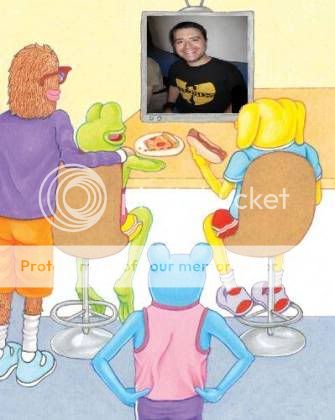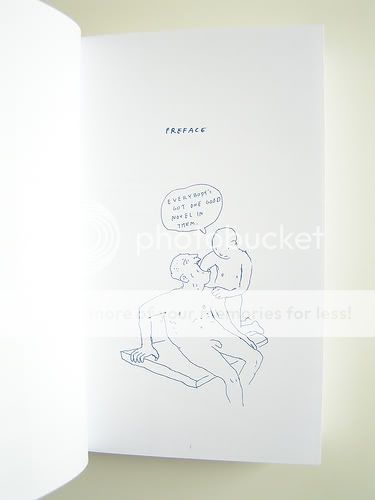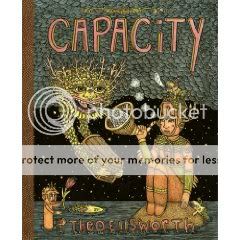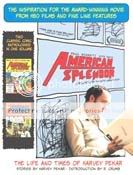Author Archive
Carnival of souls
December 27, 2008* Just to reiterate, Tom Spurgeon interviewed me about the year in alt/art comics. It was a hoot.
* Wow: a judge has granted 20th Century Fox’s copyright ownership claim over the Watchmen film. He appears to be encouraging Fox and Warner Bros., which made the movie, to work something out rather than giving the thumbs up to Fox’s stated goal of preventing the film’s release, though. And somewhere in Northampton, Alan Moore raises a chalice to Glycon in thanks.
* Shaggy reports that Gossip Girl Season One will be on sale at Target on Sunday for the low low price of $17. Mark your calendars.
* Speaking of bargains, Fantagraphics is having a 25% off/free shipping sale on orders of $50 or more at its website through the end of the year. Go blow some Christmas cash.
* A part of me is glad that They’re having trouble funding the next Narnia movie. A bit of this is due to me falling on the Tolkien side of the Tolkien/Lewis debate that dates back to Tolkien and Lewis themselves, but it’s also because everything I’ve seen about the Narnia movies so far looks like a desperate, transparent Tolkienization of the source material. (Via AICN.)
* Bloody Disgusting says they have some plot details about the Ron Moore-scripted prequel to The Thing, but it looks to me like they got their wires crossed and are reporting the plot of the original as the plot of this prequel. Seriously, what they’ve posted doesn’t make any sense. But hey, Ronald D. Moore and The Thing. That’s not too shabby.
* And Bloody D redeems itself with its annual Top 10 Best and Worst Horror Movie Posters lists. I certainly don’t agree with all their choices–I think Doomsday‘s logo approach stuck out in a sea of murky blue, for example–but they’re dead on when they call for one-sheets and posters to show more effort than just running a still through Photoshop.
* This is interesting to me: political blogger Matthew Yglesias, who is a bit of a comics nerd but not a huge one, disliked The Spirit but not in a venom-spewing, “fuck that douchebag” kind of way–he thought the plot was cockamamie, basically. Not a word about the crazy dialogue or the hambone acting or the tone vis a vis Eisner’s originals. I am really, really curious about this movie.
* AdHouse presents its 2009 release slate.
* I move in a couple of circles online: One consists of people who are apt to like Marnie Stern, the other consists of people who are apt to like Brian Chippendale’s Maggots. David Allison falls in the overlap of that particular Venn diagram, as demonstrated by the aforelinked post comparing the two.
* Frank Santoro reports that those expecting a screaming match or fisticuffs to erupt upon the Kramers Ergot 7 Tour’s Brooklyn stop-mandated meeting between Santoro and David Heatley have been let down. Alas, those of us expecting a heated discussion, followed by understanding, followed by the tender blossoming of friendship as two stalwart altcomix souljaz hugged it out once and for all are also let down.
* Seeing ADDTF blogfather Bill Sherman post about making it all the way to the 27th and final volume of Iron Wok Jan, a series he was blogging about perhaps even before I started this blog, made me feel incredibly old all of a sudden.
* Jon Hastings presents his best stuff of 2008 list. He took a cartooning class taught by Matthew Thurber???
* Finally, your quote of the day:
COVINA, Calif. – Six bodies were found Thursday in the ashes of a home where a gunman in a Santa Claus costume opened fire during a Christmas Eve party before setting the house ablaze, police said.
—“Police: At least 6 dead in Christmas Eve shooting,” Christina Hoag, AP. Obviously I wanted to make some sort of joke here but the story is really awful and horrifying. Perhaps this, from later in the story, should be the real quote of the day, then:
She said she saw a teenage boy flee the house, screaming, “They shot my family.”
I’m sorry to be such a downer all the time with this stuff.
Spurgeon/Collins take two
December 26, 2008Tom Spurgeon interviewed me about the year in alternative/art comics as part of his holiday interview series this year. Woo! Like last year when we did the same thing about the year in mainstream comics, I was super-flattered and had a lot of fun. Check it out, and also marvel about how the Boy’s Club is watching me on TV in the graphic Tom whipped up for it.
Comics Time: Planetary Book 3: Leaving the 20th Century
December 26, 2008Planetary Book 3: Leaving the 20th Century
Warren Ellis, writer
John Cassaday, artist
DC/WildStorm, 2005
144 pages
$14.99
Originally written on October 23, 2005 for publication by The Comics Journal. I was an angrier person back then.
THE DUDE: How’s the smut business, Jackie?
JACKIE TREEHORN: I wouldn’t know, Dude. I deal in publishing, entertainment, political advocacy–
THE DUDE: Which one’s Logjammin’?
–Joel and Ethan Coen, The Big Lebowski
Warren Ellis wants you to take him seriously. I don’t. Partially it’s because he, the man who coined the term “pervert suits” to refer to superhero costumes, has heaped as much scorn on supercomics as the day is long, and noisily stormed away from the genre in a rage to try his hand at the wave of the future he dubbed “pop comics,” has spent most of his career as a Comics Superstar writing thinly veiled Super Friends fanfiction and is currently the author of Ultimate Fantastic Four, Iron Man, the “Ultimate Galactus” trilogy (!) and JLA: Classified. Partially it’s because this supposed anti-establishmentarian could not write a comic that didn’t feature a select group of badass illuminated übermenschen using their secret knowledge of the world to shape it into a better one for the good of the sheeplike plebes from whom this knowledge must be kept at all costs if his life depended on it. And partially it’s because his mobile-podcast-Delphi-forum digital-revolutionary comics-activist persona, his relentless touting of (say) Godspeed You Black Emperor! accompanied by diatribes about how (say) Avril Lavigne is bullshit, his name-dropping of his fetish-model friends and his close pal “Bill” Gibson, and his desire to utilize the Internet to cultivate groups of people who think and act exactly like he does coupled with his willingness to rage against the Internet when it cultivates groups of people who do not all remind me too much of an over-earnest black-clad Newcastle Brown Ale-drinking college sophomore who writes record reviews for the campus daily while not busy reading up on the connection between Terrence McKenna and the Rosicrucians at Disinformation.com. (I know this–because I was that college sophomore!!!)
But mostly, I guess, it’s the superhero thing. I feel for Ellis because he’s so obviously conflicted in his feelings about that which Siegel & Shuster and Lee & Kirby hath wrought. How else to explain the cognitive dissonance of his Jan. 8, 2005 “Streaming” column for the comics news website The Pulse, in which he dismissively proclaims the following:
“I think possibly [excellence] is measured in how something grabs at you, how it makes you feel, what it does to your brain, what it says to you. For some people, yeah, that’s going to be all about what’s in Green Lantern’s underpants or whatever, and that’s okay. Personally, I look for the Rock And Roll and the Manic Pop Thrill elsewhere. My point, if I have one at all, is that this year the majors are focussed [sic] on each other, and on making millions off the handful of old characters we already know. There are no surprises to be had out of “mainstream” DC and Marvel in the coming year. Which means it’s down to the rest of the medium to provide them.
This, of course, while Ellis was busy accepting Avi Arad’s dirty American dollars for rejiggering armored avenger Iron Man (he used to use repulsor rays–now he’s into the societally transformative power of cellphone technology!), armored dictator Dr. Doom (he used to rule an Eastern European nation with an iron fist–now he’s rules a commune of hipsters in Amsterdam with mind-controlling cyber-tattoos!), and godlike planet-eater Galactus (he used to be a big huge guy in a purple helmet–now he’s a virus-like swarm that’s the living embodiment of the Fermi Paradox! And oh, he’s called Gah Lak Tus now, because that’s less ridiculous somehow!).
The point, I suppose, is that people who developed a coterie of camgirl acolytes by shitting all over superhero comics probably shouldn’t write them without expecting to be hoist by their own petard, and not coincidentally creating some of the dullest freaking superhero comics in the history of forever. (Thank goodness Marvel has only managed to actually release two issues of Ellis’s Iron Man, as I think that’s about as much technophilic tedium anyone could take before pulling a Unabomber.) At the very least, such people should develop a much deeper cover for their closeted compulsion to write stories about metahuman do-gooders blowing things up with their awesomeness. And that, in a nutshell, is what Ellis has done in Planetary, the title that like as not is what enables people to refer to him in the same breath as an Alan Moore or a Grant Morrison without involuntarily giggling.
Planetary concerns a trio of superpowered individuals–a temperature-controlling albino named Elijah Snow (get it?), a superstrong/superfast/supertough PVC enthusiast named Jakita Wagner, and a long-haired technopath named the Drummer–who flit about the world investigating various bits of pop- and pulp-culture fictional ephemera that, it turns out, happen to constitute the world’s real “secret history.” Basically, there really is a Godzilla, a Doc Savage, an Incredible Shinking Man (a blacklisted Communist sympathizer subjected to cruel experimentation by the United States government, naturally)–it’s a bit like the plot of Return of the Living Dead, in other words–and it’s up to our trio of “mystery archaeologists” (to use the pretentiously juxtaposed job description assigned them by Ellis) to use this knowledge for good, or something.
Their primary opponents in this quest are the Four, a team of enormously powerful metahumans who rule the world and just happen to be badass what-if versions of the Fantastic Four. In many ways they resemble the titular superteam from another Ellis creation, The Authority, who are a team of enormously powerful metahumans who rule the world and just happen to be badass what-if versions of the Justice League, except that the Four are bad guys and the Authority are good guys. Now Ellis, that lovable scamp, has been known to claim that the Authority are the villains of their comic, but to paraphrase Harrison Ford, “You can say this shit, Warren, but you sure can’t type it”; you’d have to be a mystery archaeologist to unearth evidence of the Authority’s villainy from the text itself, which reads like a prolonged MASH note to the group’s hyperviolent Lefterventionism. (Shit, man, you wanna read a genuine critique of the superheroes-take-over idea, read Mark Gruenwald’s Squadron Supreme.) Regardless, that the man who’s derided supercomics as a go-nowhere culture of remixes has created at least two comics that revolve around Fatboy Slim dance versions of Big Two teams says more about Ellis than his inescapable “what I’m listening to/what I’m reading” lists, despite his efforts to portray things to the contrary.
Planetary has a couple of things going for it–neither of which is its endless recycled riffery on superior genre entertainment. “Hey, it’s the Hulk–only DEADLIER!” “Hey, it’s a John Woo movie–only WEIRDER!” “Hey, it’s Sherlock Holmes–only he’s the leader of the ILLUMINATI and he’s brought DRACULA as his MUSCLE!” “Hey, it’s Tarzan, only he FUCKS MONKEYS!”–you’ve now experienced the majesty of Ellis’s condescending chop-shop work on stuff he’s too embarrassed to straight-up enjoy. Perhaps the nadir of this tendency is the issue in which a troupe of Vertigo-character analogues appear and are rejected as the hopelessly dated relics of their Thatcherian era–after which Ellis’s Vertigo character, Transmetropolitan‘s Spider Jerusalem, shows up and is duly crowned the trail-blazing heir to Gaiman, Moore et al. In other words, pretty much everything sucks–until Ellis puts his stamp on it, at which point it’s the tits. This is morally and aesthetically superior to milking “The Death of Gwen Stacy” for thirty years how, exactly?
But everything’s drawn beautifully, which is Planetary‘s first virtue. Artist John Cassaday can get a little lazy with the backgrounds, but his figure work is astonishing (no pun intended, X-fans!), all warm curves shot from fascinating angles. He’s an excellent choreographer of action (see Chapter 16’s wire-fu homage) and a prodigious talent when it comes to conveying Ellis’s admittedly sharp pacing choices (as in the the silent five-panel sequence where the team’s attempt to infiltrate the Four’s headquarters is discovered and thwarted with literally earth-shaking violence). Cassaday’s go-to colorist Laura Martin is every bit as compelling here. Avoiding both the vomit-like palette of greenish browns that mars much of DC’s “serious” output and the Skittle-explosion Photoshop slop of the big guns, her sensible and sensual colors perfectly fill out the contours of Cassaday’s pencils. Her monochromatic work is always a sight to behold–like her contemporary Dave Stewart, she can do more with one color than most colorists can do with, well, all of them.
Virtue number two is a structural one. Earlier volumes of Planetary were interesting for the way Ellis bypassed the traditional climactic slugfest of superherodom for an approach that genuinely mirrored that of (yep) archaeology. More often than not, Snow, Wagner, and Drums would show up after the action took place–investigating gargantuan radioactive lizard corpses on Monster Island, watching a spectral flashback to a Hong Kong cop wrongly slain, and so forth. As Ellis’s subconscious yearning to write Secret Wars took over this tactic was mostly abandoned, but it’s been replaced by what may end up being the most drawn-out prelude to a final confrontation between protagonists and villains in superhero comics history. Each issue contains a small step forward or push backward for the Planetary team’s quest to thwart the Four, who are so powerful that they’re nearly omnipotent and therefore require a whole lot of planning and effort to thwart. Volume Three culminates with the team’s first successful mano-a-mano with a member of the Four (the Human Torch knockoff)–it’s taken eighteen issues for them to take out their adversaries’ weakest link. Ellis craftily builds the Four into such a formidable obstacle that we’re more than willing to follow the Planetary crew’s long and winding road for the sense that they’ll surmount that obstacle in the end.
It’d be nice if our drivers on that road were at all interesting, though, and that’s ultimately Planetary‘s fatal flaw. Swap the color schemes and the sex organs and you’d be hard pressed to spot the difference between main characters Elijah Snow and Jakita Wagner at all. Consisting of virtually nothing but the type of deadpan “I’m incredibly blasé about this outrageously cool thing that I’m looking at”isms that Ellis has somehow made a career out of, their dialogue is completely interchangeable; indeed, one of the few non-Cassaday pleasures to be had from Volume Three is the flashback sequence from back when Snow still spoke in a Claremontian down-home American dialect, since if there’s any other way in which Snow is different from Wagner–or Apollo, the Midnighter, Jack Hawksmoor, Jenny Sparks, etc etc etc–I’d love to hear about it. (I’m reasonably sure Spider Jerusalem smoked more, but of course tracking the number of times Ellis added “substance abuser” to “ubercompetent badass” and called it a personality would require a whole ‘nother essay.) Ellis characters are little more than dim echoes of things that made other characters interesting, wrapped in skin, adorned with a superpower and a kewl outfit, and pushed on-panel to kill a few hundred thousand people, kick someone in the junk, and recite whatever Ellis read on Metafilter that day.
They’re just superheroes with a slightly better iTunes playlist. One with lots of podcast subscriptions, no doubt. Sigh. Warren, call it “Galactus” and be done with it, already.
Merry Christmas!
December 25, 2008Sucking in rhythm and sorrow
December 24, 2008I saw Twilight a couple weeks ago and Let the Right One In this evening, and frankly I’m panicking. Why? Because we are raising a generation of children that is woefully unprepared for the vampire threat.
Children, vampires are not your friends. They’re not your soulmates. They’re not your first love. They don’t glitter in the sunlight. They don’t solve Rubik’s Cubes and send you messages in Morse code. They will not protect you from bullies, runaway vans, or other vampires. They will not whisk you away from your coldly beautiful northern-latitude environment to be united with them forever. They will bite you on the neck and suck your blood out until you die. I really can’t stress that last point enough, children. The only thing to do when you run into the bloodsucking undead is to grab yourself a good sharp wooden stake and drive it straight through their hearts. This is because, as I said, vampires are not your friends.
I’ll be taking up a collection to purchase and mail copies of The Lost Boys to every 11-year-old in America shortly. For now, I suppose I’ll just have to talk about the movies, dangerous pro-vampire propaganda though they both may be.
I don’t run screaming from (or screaming at) Twilight the way a lot of horror fans do. The Missus really liked the books, for two reasons I think: 1) She enjoyed their vampiric mythos/hierarchy/taxonomy; 2) She enjoyed how they depicted the ideal teen-girl romance. A beautiful boy who loves you more than life itself, won’t have sex with you until you’re married, and never needs to sleep so he can stay up in your room all night holding you and talking? Sign the 16-year-old Missus up! And indeed I can appreciate those aspects of the story as well. True love among teenagers really doesn’t have a whole lot of pop-culture support at this point–god knows I could have used some when I was a kid–and there’s something, I dunno, rebellious about the notion that this girl knows her heart better than anyone else. Yeah, I suppose there’s a creepy Mormon subtext to all this, but the fact that its vampires we’re talking about will hopefully get some undergarments in a twist anyway.
I haven’t read the books so I can’t speak to how well the film does or doesn’t get it, but one thing it does very well is take advantage of gorgeous Pacific Northwest scenery. Watching our tormented young vampire bound around amid the Washington rainforests, all those rich greens and blues, makes you wonder why more movies can’t be set there. It also does high school pretty well: aside from the two leads, or really maybe just Robert Pattinson’s Edward Cullen, most of the kids you see are convincingly teenaged, awkwardly but not miserably coming to terms with becoming their own individual people. There’s a lot of nervous joking and showing-off of boobs and things like that. Credit director Catherine Hardwicke’s experience on Thirteen.
It’s not a terribly good movie for all that, though. To be blunt, Pattinson and Kristin Stewart as Bella deliver most of their lines like they’re barely holding in a bowel movement–every word feels forced out through clenched teeth and short breath. Bella is an aggressively uninteresting person, with the possible exception of her endemic clumsiness, but even that just makes her seem more Mary Sue-ish as half the guys in the high school, not to mention the drop-dead gorgeous vampire, fall all over her. I’ve heard complaints (including from the Missus, who found the movie very heavy-handed given that nearly everyone who saw it would have read the books and didn’t need things hammered home) that the romance and attendant “I’m a vampire” confession come on too fast, but I didn’t notice it. For me the big pacing problem was with the antagonist vampires, who have a few foreshadowing attacks, then basically come out of nowhere (in the middle of a vampire-family baseball game, of all things), upend the entire story, and get dispatched within the space of about 20 minutes total during the latter third of the film. It felt like the filmmakers just threw up their hands and spliced it in at random. The whole project feels a bit like the work of people who aren’t quite sure they’re gonna pull this thing off.
Let the Right One In, on the other hand, is a film that feels like every frame was considered and labored over. That leads to an extremely laconic pace–you really feel every one of its 114 minutes–but, at its best moments, a feeling like you’re watching No Country for Old Men with vampires instead of Mexicans and snow instead of desert. Like that film, and Twilight for that matter, it makes excellent use of its unique locale, in this case the snows of Sweden. The visual emphasis on the contrast between black night or gray day and white snow is constant and engrossing, and the opening-credits snowfall alone is a hall-of-fame image. I think that many of the memorable horror movies of recent years have been exceptionally well made and lovely as films, from The Descent‘s opening sequence and use of reds to I Am Legend, Cloverfield, War of the Worlds, and 28 Days/Weeks Later‘s use of ruined and abandoned cityscapes to The Mist‘s handheld immediacy to The Ruins fashion photography-derived cinematography, but this is the loveliest, the filmiest, of the lot. It is, in the words of Ricky Jay in Boogie Nights, a real film.
And lest you think it’s all landscapes and creatively framed portraits, there’s a plethora of memorable horror images to be found here as well. Indeed, the care given to making the non-horror material so beautiful seems to reinforce the similar attention paid to crafting unnerving scares, and vice versa. The murder set pieces are chillingly blasé, with a tinge of Hostel matter-of-factness. The few overt moments of vampire supernaturalism are subtle and freaky enough that at first I wasn’t even sure I’d seen them correctly. Gore is far from constant, but it’s creative and hard to shake when it does show up. The film has the power to shock using the basic tenets of vampire lore, which is saying something given how shopworn such things can be. And when it shifts gears into sequences involving more run-of-the-mill violence, particularly in the final scene with the bullies, it’s just as disturbing. The only unsuccessful moment involves an attack by a pride of CGI cats that stands out for its obvious special-effectness in a film where the digital work is frequently so subtle as to be in the “did I just see what I thought I saw?” category–it also has countless similar scenes of cute animals attacking people for laffs in shitty post-There’s Something About Mary comedy trailers for the past decade going against it. over. But even there I’m basically okay with it, since it jibes with the lore and since compared to what usually happens to cats and dogs and things in horror movies these days it’s refreshingly good-natured.
The visuals are deployed in service of a rewardingly complex story about a bullied tween and the girl next door, and there really isn’t any monkeying around about whether or not she’s really a vampire. We learn pretty damn quick that she sure is, which I again thought refreshing–after all, no one goes to a vampire movie like it’s a mystery. The pleasure and complexity of the film is following the basic plot as it intersects with three prominent and nuanced subplots.
First there’s the vampire girl Eli’s adult caretaker, who by the time we meet him is old and increasingly bad at his job of murdering people and supplying Eli with their blood. (Reminiscent of Mahogany in “The Midnight Meat Train,” even in methodology.) He’s a sad figure, but the film surprised me with how far it was willing to take that sadness, how furious it seemed to ultimately be about it. And bless its heart, it never comes right out and says what we all suspect about how his relationship with Eli began. It hangs there like a reproach against the film’s own resolution.
Then there’s the saga of Eli’s victims. Normally horror stories that take a sympathetic approach to their monsters “blame the victim,” as it were, showing the humans who the monsters hunt and then who eventually hunt the monster to be provincial, small-minded, and just as evil in their own way as the creatures they’re fighting. The humans are the real monsters, etc. Not so here, even when all the cues we’re receiving from their age and their rough-edged ways and their drinking and smoking signal us to expect otherwise. All told, the lives of three perfectly good-hearted people who genuinely care about each other are cruelly snuffed out by Eli. She’s not a bwa-ha-ha cacklingly evil vampire in the Dracula/’Salem’s Lot mode, she’s portrayed as someone whose well-being we should care about, but neither she nor the film make any bones about the fact that she murders innocent people to survive. As a result the movie plays with audience identification in the same unexpected, effective fashion as, say, The Wicker Man. Who are we rooting for, and what does that say about us?
Finally there’s our hero, Oskar, and the bullies who bedevil him. There’s plenty of comeuppance dealt out in all the right places, and it’s always pretty satisfying…for a time. But one bully cries, another is clearly miserable with his role as a Judas goat, and the ringleader is equally clearly doing unto others what has been done unto him. When their time comes, I snorted a “serves ’em right” laugh or two, but I didn’t laugh for long.
But even beyond the bully storyline proper, what they do is give Oskar a reason to do what he does and be how he is. Something that the bullying has done to him psychologically prepares him to fall into the arms of Eli, if you will–that’s something we never see with Bella and Edward. At age 12, an outcast clinging to fleeting moments of genuine happiness with his divorced parents, a hapless victim of children who are perhaps even more miserable than him and certainly less redeemable, an inability to see beyond the end of the school year…you can see why he would care so deeply for this little girl who shows him kindness, lets him in on her secrets. For that matter you can see why the reverse would be true (provided you’re willing to grant vampires that luxury, which for some reason seems to be a whole lot less of a problem for horror fans with this movie than with stuff by Stephenie Meyer or Anne Rice). Perpetually 12 years old, trapped in a relationship long past its expiration date, exposed daily to suffering, possibly the victim of abuse herself in some long-ago life…she needs a kindred spirit. If Bella and Edward’s relationship is a romantic ideal, Oskar and Eli’s is one grounded in personal psychological shortcomings and damage, as well as tenderness and vulnerability and play. Their relationship feels real. Doomed, sad, and real.
Comics Time: The Other Side
December 24, 2008The Other Side #1-2
Jason Aaron, writer
Cameron Stewart, artist
DC/Vertigo, 2005
32 pages each
$2.99 each
Originally written on November 22, 2006 for publication by The Comics Journal. I went in for vitriol back then.
Agent Orange and The Other Side might seem different on the surface, in that the former is a chemical defoliant used during the Vietnam War and the latter is a comic book about the Vietnam War. But look a little deeper and you’ll find that they have two important characteristics in common: They both led to the destruction of trees, and they are both fucking awful.
No shopworn Vietnam shibboleth goes un-beaten-into-the-ground by writer Jason Aaron, who uses an apparent real-life friendship with author Gustav Halford, whose book The Short Timers was adapted into Stanley Kubrick’s Full Metal Jacket, as an excuse to pilfer every last sample-ready soundbyte from that film, strip it of context, and fire it like a Deer Hunter Russian-roulette bullet directly at the reader’s brain, with predictably hideous results. Nearly every line of dialogue seems to consist solely clichés strung together like a necklace of human ears: “IF YOU ARE NOT SQUARED AWAY AND BORN-AGAIN-HARD…THE GOOK WILL FUCK YOU UP BEYOND ALL RECOGNITION!” Complementing this one-dimensional portrayal of the American fighting man as an obscenity-spewing kill-crazy redneck motivated alternately by bloodthirsty chauvinism, pants-shitting terror and batshit insanity is the depiction of the Vietnamese everysoldier as a pristine holy warrior who talks like a cross between Mao and the Mandarin. The series’ parallel structure only highlights the unintentional hilarity of the characterizations. I couldn’t possibly illustrate this more clearly than by simply transcribing issue two, page one—which is split into two panels depicting the two main characters and their fellow soldiers—in its entirety:
[LEFT]
NARRATOR: The Twelfth Lunar Month in the Year of the Sheep. Vietnam. Somewhere between the coastal city of Vinh and the Laotian border. Deep within the holy sanctuary of the rain forest, we begin our historic journey with a cheer.
LEAD SOLDIER: For the liberation of our compatriots, the defense of our families, the defeat of our oppressors and the reunification of our fatherland…
ALL: Let’s march south!
[RIGHT]
NARRATOR: December 1967. Vietnam. Quan Nam province. Chest deep in the stinking mud of Danang, I begin my tour of duty digging holes for men to die in.
SOLDIER 1: Welcome to the exotic Indochinese Peninsula, new guy. Where heroes die young, and assholes live forever.
SOLDIER 2: Where dinks don’t die, they just go to hell and regroup.
SOLDIER 3: You think it sucks now? Just wait ’til you’re wasted.
SOLDIER 4: Whoopee, we’re all gonna die.
Can you guess which side is which? Holy Christ, it makes that scene from Platoon where the guy shows Charlie Sheen the picture of his sweetheart back home look inspired. Even poor Cameron Stewart gets fragged: His poppy, buoyant art has been a treat in semi-revisionist superbooks like Catwoman, SeaGuy and The Manhattan Guardian, but here his figurework goes from solid to stolid to squalid, losing all sense of movement and stripping the battle scenes (massacres all, naturally) of any power to grip, excite or terrify, not that they’d have much of a shot at doing so as written anyway. What was that quote from Full Metal Jacket again? Oh yeah: “I am in a world of shit.”
Carnival of souls
December 23, 2008* Fantagraphics’ Eric Reynolds lists his books of the year.
* Curt Purcell explains why he thinks The Spirit will be different from Frank Miller’s past reimaginings of established characters, like his Batman and Daredevil comics.
* Speaking of Cloverfield, apparently that gigantic toy of the monster came out! I discovered this by watching a video in which it harasses Rich “Fourfour” Juzwiak’s cats.
* And finally, Twin Peaks: The Sneaker! The kids love this one.
(Via my pal and frequent ADDTF commenter Jason “Shaggy” Erwin, who has a blog now!)
Woke up with a monster
December 22, 2008Thanks to the magic of the special feature listed on the packaging of countless bare-bones DVD releases as “scene selection” I am currently watching Cloverfield sans its opening twenty minutes. The movie had been steadily growing on me since I first saw it a little less than a year ago; it’s not unlike The Mist in that regard, but oddly it is unlike I Am Legend, which ending aside I preferred to the other two entries in Winter ’07-’08’s apocalyptic monster movie festival at the time but since find myself largely uninterested in revisiting. My guess, and I think I’ve said this before, is that it’s because I’m a monster man at heart, and IAL‘s critters were the weakest part of that movie while the monsters in Cloverfield and The Mist were highlights.
Anyway, the destruction of Manhattan by the bastard offspring of Lovecraft and Toho is just as awe-inspiring and as soul-crushing as I remember it being. I’m not going to say it’s a relentless grinding down of your nerves, because there’s the fanservice “girl knows about Superman” humor in the tunnel scene, but it’s grim and it plays those 9/11 notes expertly. Is it the best giant-monster movie I’ve ever seen? You bet. I’d already had a hunch it might end up on my all-time favorites list the next time I update it, and so far…yep. The stuff that I like here is really the kind of stuff I like, you know?
But then there’s the stuff I don’t like, and in skipping ahead to the moment where the excrement hits the air conditioning I stumbled across exactly what that is. Behold the final line spoken by one of our partygoers before the attack begins:
You gotta learn to forget the world and hang on to the people you care about the most.
Also?
In all seriousness, it’s not even that I disagree with the sentiment. In fact that’s pretty much how I’m living my life these days! It’s just that nothing about how it’s expressed throughout the movie rises above the most predictable, clichéd ways of doing so. Lizzy Caplan excepted, the performances don’t help either. I’m struck in this re-watching by how one-note lead actor Michael Stahl-David’s performance is; it seems like he based his character’s reaction to trauma solely on what he’s seen such things look and sound like in the movies. Compare and contrast with the three actors in The Blair Witch Project, which I also re-watched recently, and, well, there isn’t any comparison. The special effects show a lot more seams on the small screen too, oddly enough, I guess because it’s easier for the eye to parse the constantly moving camera.
Good movie anyway. Heck, I’m leaning toward great movie anyway.
Old stuff on Cloverfield here, here, and here.
PS: The girl regaining consciousness with a “hey” is still totally hilariously awful.
“I don’t owe the fans a goddamn thing.”
December 22, 2008Carnival of souls
December 22, 2008* Tom Spurgeon kicks off his annual holiday interview series with a conversation with Fantagraphics co-honcho Kim Thompson. It’s both uplifting to hear a great publisher talk about what he does and why/how he does it, and depressing even to hear him joke that had he known then what he knows now he might never have given it a try.
* The two guys who run Michael Bay’s horror remake factory Platinum Dunes sound like They’re not remaking Rosemary’s Baby and might not remake The Birds after all. It’s really something to hear how dopey they sound even when explaining non-dopey decisions like that one. (Via Dread Central.)
* Josh Cotter’s last few “Driven by Lemons” sketchbook strips have been particularly lovely.
* John Jakala casts a skeptical eye at Brubaker/Fraction/Aja et al’s Immortal Iron Fist as compared to similar manga series. To me, though, the way he critiques it just makes it clear that IIF was going for something different than Naruto or Bleach. I suppose it’s possible they tried to do a balls-out superhero manga and failed, but it seems unlikely. It’s certainly fine to prefer one to the other, of course.
* The Daily Cross Hatch asks a plethora of comics personages to list their favorite books of the year. I could have done with a few fewer NYC comics scenesters plugging their buddies’ books, but it’s still an interesting sampling of opinions. Capacity gets a lot of love, which is terrific given how close I came to overlooking the book entirely. My favorite bit is Dash Shaw’s praise for the great Ross Campbell’s Wet Moon 4:
Campbell knows who he is and what he likes and his comics are born out of his personality and obsessions. His work is unique and untouchable. This man is at peace with himself. That is an enviable life. If Optic Nerve was awesome it would look like this. The Abandoned 2 was going to be his masterwork but I’m okay with more Wet Moon instead. Fuck Tokyopop.
I don’t necessarily agree with the Optic Nerve dig, but Shaw’s dead on in detecting a kinship there. It’s just the look and the milieu of Campbell’s stories that prevents altcomix slice-of-life lovers from jumping aboard, or really even acknowledging its existence. Read Wet Moon!
Comics Time: The Mystery of Woolverine Woo-Bait
December 22, 2008The Mystery of Woolverine Woo-Bait
Joe Coleman, writer/artist
Fantagraphics, December 2004
40 pages
$4.95
We serial-killer buffs are an odd lot. I think there are different ways people come to a fascination with famous multiple murderers, but one of the most common and influential in terms of the resulting art and pop/junk/cult culture artifacts is to see them as a real-world extension of Famous Monsters of Filmland. When you’ve cycled through the Universal monsters, the Hammer horrors, the BEMs and giant irradiated monsters of ’50s science fiction, Vampira and Zacherle and the creature-feature hosts, “collecting” knowledge about ghoulish characters like Ed Gein and Albert Fish can seem like the next logical step. I think you also see the earlier serial killers–Fish, Gein, Richard Speck, Albert De Salvo, Carl Panzram, right up through Charles Whitman (technically a mass murderer, or spree killer depending on how you look at it) and Charles Manson–were and are presented in much the same way that horror movies were to children of the ’50s and ’60s, as an antidote to rules and parents and conformity. The dark side of the American dream and all that.
I’m not coming to serial killers like that. Maybe I did once; not anymore. Joe Coleman, on the other hand, is the patron saint of that approach. A trash-culture outsider-art icon, his paintings treat serial killers like medieval saints, surrounding them with the facts of their often horrendous upbringings and even more awful crimes. Woolverine Woo-Bait, originally released in 1982 and here combined with a six-page continuation that actually came out five years earlier, is sort of the comics embodiment of his aesthetic. Serial killers themselves play only a small, inspirational role, representing the “conception of the psychological make-up required to survive or mutate in the post-atomic era,” but in addition to their cameos, you’ve got the aliens from Mars Attacks, acromegalic character actor Rondo Hatton, an entire old-school freak show, mad scientists, zombie Holocaust victims, crazed square-jawed soldiers, Ed Wood repertory players Vampira and Tor Johnson, rape, disembowelment, cannibalism, a woman with two functioning sets of male genitalia where her breasts should be, Jo Jo the wolf boy…if you spent some portion of the ’90s on a David Lynch/John Waters/psychobilly-inspired sojourn through the rotten edges of post-War American culture, you’ll know what you’re in for. Coleman draws it all like a man possessed, placing his panels against backdrops and borders of schizophrenic detail. The plot is negligible–suffice it to say people do disgusting, violent, perverse, and occasionally breathtakingly racist and anti-Semitic things to one another; the point is to uncontrollably vomit all this junk back in everyone’s faces. There’s a part of me that will always have an affinity for this kind of thing, that will always enjoy being on the outside. There’s another part that stands there and says “Well, here we are, we’re Outside…now what?” Are violence and suffering holy, as Coleman argues? Or is it that they’re important to expose, that ripping off the scab like this comic does has a value to it, but there’s something unspeakably sad underneath and a failure to acknowledge or address it is an American dream of its own?
Carnival of souls
December 21, 2008* B-Sol at Vault of Horror has posted the fruits of his latest labor: The Top 25 Horror Films of the Modern Era. Like his previous Top 50 of All Time list, it was culled from lists submitted by a wide variety of horror bloggers and website writers. There are some interesting selections on there, both good and bad, and I think once again the theory that films need a little time to percolate in our minds before we feel comfortable saying “it’s the best” is borne out.
* Bad law is bad law update: Tom Spurgeon calls our attention to the case of Dwight Whorley, whose child pornography conviction included charges related to cartoon imagery and prose fiction in addition to actual pornographic photographs of children. Given recent commentary about whether unseemly speech should be protected, this seems like an instructive case to me. I don’t think you’ll find anyone who doesn’t think Whorley deserves to rot in prison for possessing the pornographic photos. On the other hand, the activities depicted in the cartoons and the fiction are imaginary, involving imaginary people. I don’t think that’s a crime, and I don’t think it should be classified as a crime, and I don’t think anyone, even a bastard like Whorley, should be convicted for it. Bad law is bad law.
* More grim news: The case of the murder of Adam Walsh, the young son of John Walsh, has long been a fascinating one to me, for a few reasons. First of all, John Walsh’s reaction to his son’s killing–creating America’s Most Wanted and thereby helping to capture countless murderers and other criminals–is the closest thing to a real-life superhero origin story I’ve ever seen. Secondly, Adam’s supposed killer is an infamous figure in serial-killer lore, Ottis Toole. Toole was the occasional partner in crime of Henry Lee Lucas; the two inspired the excellent, trailblazing horror film Henry: Portrait of a Serial Killer, and depending on how you credit their often altered or retracted confessions, they’re either among America’s most prolific murderers or its biggest bullshit artists. This article by the AP’s Matt Sedensky on the Hollywood, Florida authorities’ recent closing of the Adam Walsh case, officially pinning the blame on the long since executed Toole, points out the many lingering inconsistencies and flaws with the investigation, the confession, and the supposed case-closing. It also brings up something I either never heard or had forgotten about: the suspicion among some quarters that Jeffrey Dahmer, who lived in Florida at the time of Adam Walsh’s disappearance, might have been responsible for the murder.
*
Carnival of souls
December 20, 2008* Sean T. Collins on dead tree: The new issue of Maxim (Hillary Duff’s on the cover) features a piece I did on The Spirit, complete with Frank Miller interview quotes. “Is it crazy? You bet your fuckin’ ass it is” may be one of those quotes.
* Speaking of Frank the Tank, he’s going to be directing a new film version of Buck Rogers. Also, hee hee!
* Fantagraphics has posted a preview of Anders Nilsen’s upcoming book, Monologues for Calculating the Density of Black Holes.
* My pals Ben Morse, Ryan Penagos, and Juan Doe have comics in the Marvel Digital Holiday Special. Dig that Stephanie Buscema art.
* Here’s a photo of the creepy fashions of some voters in Kashmir.
Thought of the day
December 19, 2008I enjoy Pitchfork’s year-end best-of lists, but I enjoy them even more when I think of them as countdowns and imagine Casey Kasem reading them. “Coming in at number 34, here’s Fuck Buttons with ‘Sweet Love for Planet Earth.'”
Comics Time: Capacity
December 19, 2008Capacity
Theo Ellsworth, writer/artist
Secret Acres, October 2008
336 pages
$15
Beautiful, magical, complex, and possessed of the irresistible, quiet confidence of those for whom making art is less a choice than a given, Capacity impressed and delighted me as much as any book this year, and as much as any debut since the first issues of Skyscrapers of the Midwest. In Theo Ellsworth’s constantly unfolding details and army of mysterious, dreamlike characters, you will see the fantastical echoes of artists like William Blake, Hieronymus Bosch, Clive Barker, and Marc Bell. But before you picture a nonsensical riot of whimsy and/or grotesquerie, dig the comic’s conceit: Ellsworth, represented here by several characters that correspond with different aspects of his mind, invites you the reader (whom he directly addresses with a recurring fill-in-the-blank ______ slot where your name is supposed to go) to join him as he walks you through a sort of artistic autobiography, in which he both presents you with the contents of the minicomics and abandoned projects he’s done over the years and provides them with context. It’s an enormously endearing set-up, one that never drifts into preciousness even when the comics in question feature ultra-earnest doggerel poems about the horror of war or the nature of thought.
As a title, Capacity really does do the trick. Aside from the fact that the book is itself a braindump of as much of Ellsworth’s comics as he could fit, Ellsworth’s knockout art style is characterized by its…I want to use the word “prolixity” but that’s pejorative. Basically, scaly reptiles or dragons will seemingly have thousands of individually drawn scaled. Feathered ogres or furry monsters will have countless feathers or tufts of fur. A man surrounded by little creatures will wear clothing and hats that consist of villages of houses that contain other people and creatures who have their own house-clothing that contain other people and creatures, and so on and so on. It’s filled to capacity, in other words, but not in the crazed, violent manner of your Joe Colemans and Bald Eagles, or even the goofball non sequitur chaos of the aforementioned Marc Bell–here, the ripeness and rifeness of the imagery is inviting, immersive, evocative of environments you want to enter and explore. That’s a central trope of Ellsworth’s own relationship with his ideas, which he seems to regard as independent entities. Such is his deadpan sincerity on that point that an idea that can seem laughable or pretentious when proposed by other artists here just makes you go “well, certainly.”
By the end of the book, I was so engrossed by the uniqueness of Ellsworth’s project and the skill of its execution that I never even really thought about how potentially disjointed such a book could seem in less assured hands. But not only does it all flow rather seamlessly, there’s a final-pages reveal/twist that cleverly and delightfully links together long-abandoned story strands to uncover a throughline that was there all along. It’s a wildly successful little story-as-puzzle moment, like a great Grant Morrison comic or David Lynch film. It makes you want to go back and re-read the whole thing, not “to see what you missed” or anything but just because it would be fun and rewarding to do so. I have a feeling this will be a book I’m diving into every now and then for a long time to come.
Thought of the day
December 17, 2008Somewhere in Heaven, J.R.R. Tolkien talks to James Brown about what it’s like for everyone in a given field to owe absolutely everything to you.
Carnival of souls
December 17, 2008* Jane Espenson talks to SciFi Wire about her script for the upcoming Battlestar Galactica TV movie The Plan. As SciFi Wire puts it:
Jane Espenson, who wrote the upcoming movie Battlestar Galactica: The Plan, said that the telefilm will retell the initial story of the SCI FI Channel series, but from the perspective of the Cylons, and that it will take advantage of revelations that will come in the upcoming new episodes of the show’s fourth and final season.
But you should read the whole thing because it’s interesting to hear her talk about the process, which heavily involved director and star Edward James Olmos.
* Clive Thompson offers the best explanation I’ve yet seen about the use of torture in World of Warcraft, and suggests how it could have been done better. Because I’m thick, I’m only now grokking that torture was mandatory across all character types, not just the “evil” ones. That seems pretty dopey to me. Regardless of its provenance in fantasy literature–Gandalf and Aragorn at the very least credibly threatened to torture Gollum for information–I think most of us look at torture in fiction differently than we might have decades ago. (Via Bryan Alexander.)
* I loved Tom Spurgeon’s review of Mesmo Delivery because it’s like a much more cogent and pleasantly written version of exactly what I said about Mesmo Delivery.
* Here’s a great photoparade from the Kramers Ergot 7 signing at Desert Island in Brooklyn. I actually did the responsible thing and canceled my pre-order in hopes that someone would get it for me for Christmas. Fingers crossed! (Via Tom Spurgeon.)
* Brian Eno and Peter Jackson: two great tastes that taste great together. (Via Whitney Matheson.)
* Worn Free specializes in reproducing T-shirts worn by rock stars. I didn’t see anything that said “must buy!” to me, but I’d imagine some people reading this blog wouldn’t mind grabbing that Lester Bangs “FREEDOM OR DEATH” shirt.
* I remember reading textbooks that said “nobody knows why the dinosaurs died out.” Since then we’re now on our second prevailing theory: Looks like the asteroid idea is being phased out in favor of massive volcanic eruptions in India. Meanwhile, scientists in the Sahara have found the remnants of a prehistoric river chock full of fossils, including those of a 60-foot crocodile. Six-year-old “I Want to Be a Paleontologist When I Grow Up” Sean T. Collins is tickled pink by all of this. (Via HuffPo.)
* Here’s an insane CBS News story about a cult called SIST from a small town in Wisconsin and how they allegedly tried to hire a hitman to kill 60 people in the town, including pretty much the entire local government. It sounds a little like the “hitman,” who was actually just a motorsports salesman who says he played along with the group for a while in order to recoup $100K they owed him, sort of entrapped them into the scheme. But even so, the group appears to be really nuts and the mayor has installed bulletproof glass on her door and the group’s lawyer wears a fedora and calls CBS a communist organization…it’s fantastic.
* Not to be confused with the star of Crank, Jason Stratham of The Cold Inclusive specializes in extremely detailed and bizarre accounts of fictional sexual encounters with celebrities. “The Very Last Fucking of Steven Tyler” has a dystopian science-fiction feel to it, for example, while “Everyone Says I Love You” contains the following passage:
So. You’re on top of [Drew Barrymore], “giving her one,” as they say in post-war British literature, and she stares right up at you and says “You like that? You like fucking People magazine’s most beautiful person?”
How to respond to a question like that?
After a yearlong hiatus, he’s returned with a little something entitled “Christmas in L.A. with Julia Roberts.”
Afterwards, lying on the bed, both catching your breath, Julia says “Whew! And…scene!” and laughs. That unashamed, open-mouthed laugh she has.
I wish I’d thought of this.
Comics Time: American Splendor: The Life and Times of Harvey Pekar
December 17, 2008American Splendor: The Life and Times of Harvey Pekar
Harvey Pekar, writer
Kevin Brown, Gregory Budgett, Sean Carroll, Sue Cavey, R. Crumb, Gary Dumm, Val Mayerik, Gerry Shamray, artists
Ballantine Books, August 2003
320 pages
$15.95
I find myself a bit stymied in trying to figure out how to kick off this review, since this material has already been digested and processed by so many people. I guess I’ll go with talking about R. Crumb’s art here. Obviously it’s the strongest of Pekar’s collaborators–I know, shocker, right? Indeed I’m a little surprised he could persuade other artists to take a crack at it. Befriending the foundational artist of alternative comics back before he was famous, becoming inspired to do comics in the first place because of that friendship, and then finagling a series of collaborations out of him–that’s the most auspicious comics career kick-off this side of Marc Silvestri and Michael Turner getting paying work out of their first ever comic-con visits. But while it’s easy to see that Crumb’s technique is superior to the other cartoony guys in the book, and that his more impressionistic approach is somehow more visually stimulating and rewarding than the photorealists, I liked his character designs the best. Crumb draws Harvey and his friends and coworkers like tiny little guys out of a fairy-tale world, only with collared shirts. Pekar is a slightly hunched-over, wild-eyed ogre or hermit, his pal Mr. Boats is a roly-poly sage or scribe of some kind–that kind of thing. No? But the caricatures lose none of the nuance needed to convey Pekar’s little insights and pet peeves regarding the workaday modern world. There’s a beautifully accurate bit of body language at one point where Crumb is listening to his visiting friend while leaning against a file cabinet, and the sneer shared by those two women in that strip where the guy tries to sell them okra cracked me up.
I suppose it’s details like that that I enjoyed the most, not just in the art, but in the writing. Pekar’s penchant for describing his life’s most mundane details in what you’d imagine to be a voice just a few decibels louder than comfortable conversational level is what provides these stories with the energy they need to keep from being soul-crushingly dull, but that energy doesn’t overwhelm his capacity for keen observations. For instance, there’s this passage from a strip about how Harvey’s failed second marriage actually taught him that he could, in fact, be happy given the right circumstances:
Yeah, I got what I thought I needed and it turned out it really was what I needed. What a wonderful feeling! It’s like, y’know, when you’re not used to building stuff, like you’re not mechanically inclined, and you put something together from instructions in a book and you think you’ve done it right, but still you have no confidence. So then you turn it on and it works. Boy, what a rush!
Folks, you should have seen how thrilled I was when I managed to properly install my TiVo on the very first try! I knew exactly what Pekar meant, and that thrill of recognition was another LOL moment for me.
I think that’s what I take away from this collection: It’s kinda cute! Pekar’s an irascible guy, obviously, with no shortage of qualities that might make him tough to take in real life, but there’s something about his extravagantly straight-faced presentation of himself that’s comical and adorable. Yeah, a lot of the art is stiff or unprofessional, and yeah, a lot of the stories end like one of Brak’s Tales of Suspense, but when faced with life’s vicissitudes, a storytelling approach that acknowledges how they can weigh on you but still makes them look slightly ridiculous strikes me as being a pretty healthy one.
Carnival of souls
December 16, 2008* Happy birthday to the great Tom Spurgeon! (Via Peggy Burns.)
* My media discovery of the month: Mashed in Plastic: The David Lynch Mash-Up Album. It’s a seamlessly flowing collection of 18 mash-ups that draw from the soundtracks of David Lynch films and Twin Peaks, linked together and sprinkled throughout with astutely mixed audio clips from the movies. Before you say to yourself “That sounds kind of cheesy,” I simply advise you to take the couple minutes necessary to download the record and listen to either “The Voice of Love Is Crying” or “I’ll Be There in Twin Peaks”; if you are a David Lynch fan and you don’t get chills, I’ll eat my weight in garmonbozia. Production credits and videos are at the link as well. Be warned, though, that you might stand to see something spoilery if you’re not up to speed with all his movies. Twin Peaks virgins especially should proceed with caution. (Via Jason “Shaggy” Erwin.)
* Speaking of which: Fire Walk with Desaad. Thanks again, Rickey Purdin.

* I always wondered who all these people who supposedly fainted after hearing Chuck Palahniuk read the story “Guts” from his horror novel/anthology hybrid Haunted were. As it turns out, they’re a lot like FourFour’s Rich Juzwiak. Wow. It’s worth a read not just because it’s funny that the guy you’ve come to know and love through his cat videos or R&B reviews or ANTM recaps is part of a cult phenomenon, but because he also speaks to that same sense of “failure” as a fan of the extreme that I felt when I switched off Inside.
* Tor.com’s Douglas Cohen finishes off a series of posts on Robert E. Howard’s fab four sword’n’sorcery heroes with one on Bran Mak Morn.
* Stacie Ponder pays “a small tribute to that 80s horror trend where chicks wore sports jerseys as pajamas.” Jo Beth Willicious.
* Finally, John Cei Douglas sends Christmas greetings from Deadwood. (Via Matthew Perpetua.)
The owls are not what they seem
December 16, 2008(via)


















